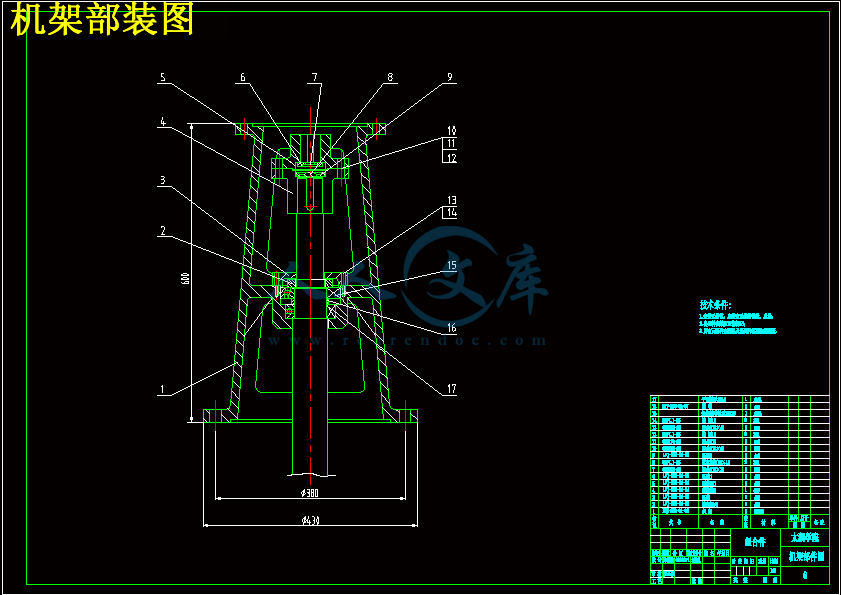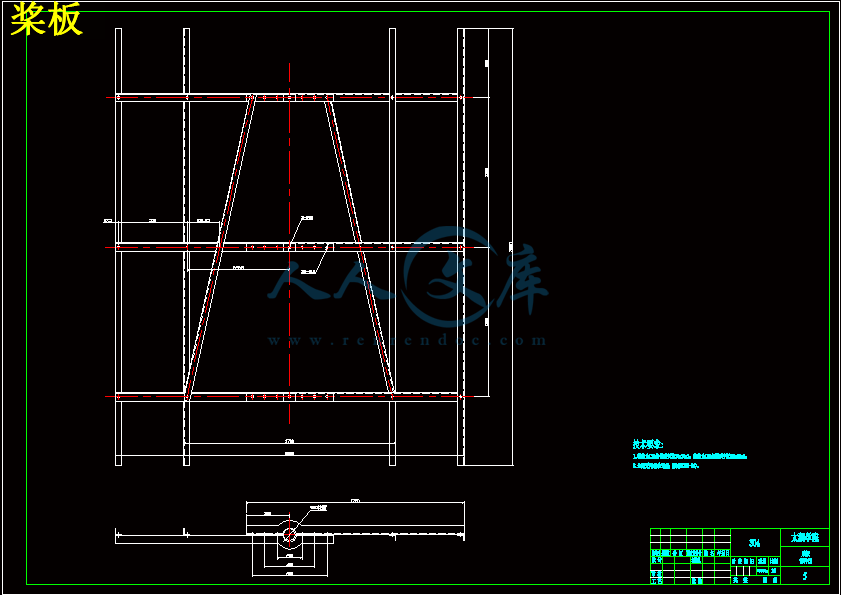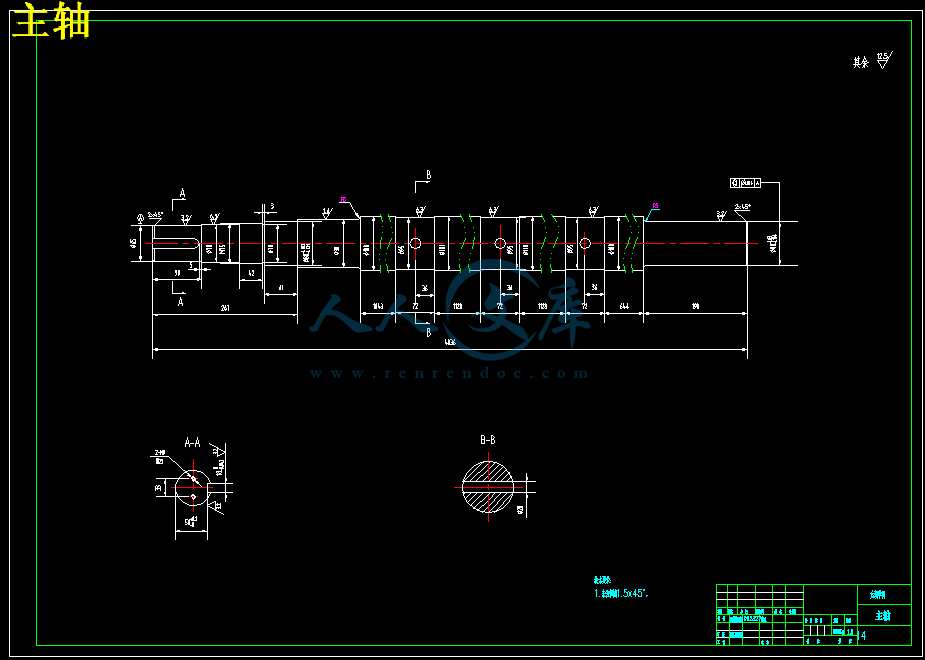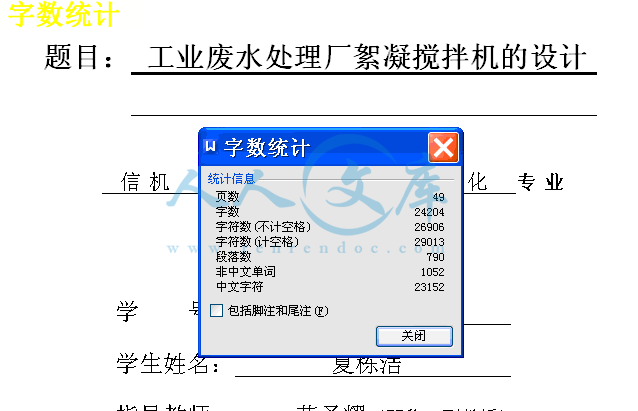摘要
搅拌机在搅拌设备中处于核心地位。在搅拌机设计及使用过程中,合理的选取搅拌机的结构,运动和工作参数,直接关系到搅拌质量和搅拌效率。完成絮凝经过的絮凝池(一般常称反映池),井水除氟设备海扬,在净水料理中占据重要的名望。自然水中的悬浮精神及肢体精神的粒径分外微细。为去除这些精神平日借助于混凝的权谋,也就是说在原水中参与适当的混凝剂,经过充塞混和,使胶体安静性被坏(脱稳)并与混凝剂水介后的聚合物相吸附,使颗粒具有絮凝本能机能。而絮凝池的目的就是创造合适的水力条件使这种具有絮凝性能的颗粒在相互接触中聚集,以形成较大的絮凝体(絮粒)。因此,反应池设计是否确当,关系到絮凝的效果,而絮凝的效果又直接影响后续处理的沉淀效果。絮凝搅拌机是絮凝池机械搅拌的装置,它主要用于废水处理的搅拌过程。
本设计提到了反应池的结构设计,搅拌机的结构设计,电动机及减速器的选型,搅拌机支架设计,密封设计以及其工艺流程。在设计过程中,我们应该充分考虑桨叶距离絮凝池顶端、底端以及侧壁预留的距离,还有就是轴的密封问题。
关键词:絮凝池;混凝剂;沉淀效果;絮凝性能
Abstract
The mixer is at the core position in the mixing equipment. In agitator design and use of the process, select the reasonable structure of the mixer, motion parameters and work, directly related to the mixing quality and efficiency of stirring. Accomplish flocculation pool (often called the flocculation after reflecting pool), water fluoride removal equipment HIYOUNG, occupy the important position in water purification cuisine. Suspended spirit and spirit of natural water body size is fine. To remove these spiritual weekdays by coagulation of trickery, that is to say in the appropriate coagulant in water, after full mixing, so that colloidal quiet is bad (destabilization) and phase adsorption and mixed polymer coagulant water after, the particles with flocculation performance. The flocculation pool purpose is to create appropriate waterpower condition makes this aggregation with flocculation properties of particles in contact with each other, to form a large flocs (flocs). Therefore, the reaction pool design is appropriate, in relation to the effect of flocculation, sedimentation and flocculation effect has direct impact to follow-up treatment. The flocculation mixer is flocculation pool mechanicalrabble device, which is mainly used for mixing process in wastewater treatment.
This design to structure design reaction tank, the structure design of mixer, selection of motor and reducer, mixer stent design, seal design and its processes. In the design process, we should give full consideration to blade distance flocculation pool at the top, bottom and side wall reserved distance, there is the problem of shaft seal.
Keywords: Flocculation pool;Coagulant;Precipitayion effect;Flocculation function
目录
摘要 III
Abstract IV
目录 V
1 绪论 1
1.1 絮凝搅拌机的研究内容和意义 1
1.1.1 设计絮凝搅拌机的目的、意义 1
1.1.2 絮凝搅拌机的研究范围 1
1.1.3 絮凝搅拌机的要达到的技术要求 1
1.2 国内外的发展概况 2
1.2.1 国内外发展概述 2
1.2.2 国内外发展状况 2
1.2.3 存在问题 4
1.3 设计搅拌机应达到的要求 4
1.3.1 反应搅拌机的工作原理 4
1.3.2 絮凝的工作原理 5
1.3.3 水处理中的搅拌设备 5
1.3.4 絮凝搅拌机的适应条件和构造 6
1.3.5 设计思路 7
2 反应池的结构设计 8
2.1 引言 8
2.2 絮凝反应理论知识 9
2.3 反应池的工艺性分析 12
2.4 反应池的技术要求及设计效果 16
3 搅拌机的结构设计 18
3.1 设计数据 18
3.2 设计要求 18
3.3 设计计算数据 19
3.4 桨叶的设计 20
3.4.1 桨叶结构尺寸确定 20
3.4.2 搅拌器转速计算 20
3.4.3 搅拌功率计算 22
4 电动机及减速器的选型 23
4.1 减速器和电动机的选型条件 23
4.2 电动机与减速器的选择 23
4.3 联轴器的选型 25
4.4 搅拌轴的设计 26
4.5 轴与桨叶、联轴器的连接 27
4.5.1 桨式搅拌器与轴的连接 27
4.5.2 联轴器与轴的连接 27
4.6 轴承的选型以及轴的最终确定 27
5 搅拌机支架设计 28
5.1 搅拌机的支承部分 28
5.1.1 机座 28
5.1.2 轴承装置 28
5.2 水下支撑座的设计 29
5.2.1 轴承的选型 29
5.2.2 支撑套的设计 30
6 密封设计 31
6.1 密封装置的类型 31
6.2 填料密封 31
6.2.1 填料的种类 31
6.2.2 填料的选择 32
6.2.3 填料的合理装填 32
6.2.4 成型填料密封 32
6.3 机械密封 33
6.3.1 机械密封的工作原理 33
6.3.2 机械密封前的准备工作 34
6.3.3 机械密封材料 34
6.3.4 机械密封与软填料密封比较 35
6.4 轴的密封选择 35
7 结 论 37
参考文献 38
谢 辞 39
1 绪论
搅拌可以使两种或多种不同的物质在彼此之中互相分散,从而达到均匀混合;也可以加速传热和传质过程。在工业生产中,搅拌操作时从化学工业开始的,围绕食品、纤维、造纸、石油、水处理等,作为工艺过程的一部分而被广泛应用。本章主要对絮凝搅拌机的研究内容和意义、国内外的发展概况以及设计搅拌机应达到的要求进行了阐述。
1.1 絮凝搅拌机的研究内容和意义
本节讲述了设计絮凝搅拌机的目的、意义,絮凝搅拌机的研究范围以及要达到的技术要求。
1.1.1 设计絮凝搅拌机的目的、意义
废水处理中反应搅拌机的目的是由电机作为驱动装置,经减速器联轴器带到直桨叶旋转使胶体颗粒絮凝形成较大的颗粒,以利沉淀,以满足水处理中水质净化的要求。
废水处理中反应搅拌机的意义是在絮拟池中加入絮拟剂,在絮拟剂的作用下,通过搅拌机的作用,使原水中的悬浮物质及胶体物质凝聚,形成较大的颗粒,以利于沉淀,达到净水的目的。
1.1.2 絮凝搅拌机的研究范围
本题目主要涉及水处理中絮凝工艺中反应搅拌机的设备设计,主要解决的问题是水处理中该设备的设计,包括:主轴、絮凝搅拌机、电动机及减速器的选型、支撑装置设计、轴的密封设置、絮凝池的设计,并画出相应的设备图。
1.1.3 絮凝搅拌机的要达到的技术要求
搅拌机分为常规饲料搅拌机和添加剂搅拌机两种。常规饲料搅拌机有立式和卧式两种。立式搅拌机搅拌时间一般为,卧式机则为左右,搅拌配合饲料时应分批搅拌。立式搅拌机的优点是混合均匀,动力消耗少,缺点是混合时间长,生产率低,装料、出料不充分。卧式搅拌机主要工作部件为搅动叶片,叶片分为内外两层,它们的螺旋方向相反。在工作时叶片搅动饲料,使内外两层饲料作相对运动,以达到混合的目的。卧式搅拌机的优点是效率高,装料、出料迅速,缺点是动力消耗较大,占地面积大,价格也较高,因此一般较少采用。
在絮凝过程中,搅拌的作用有两点:一是混合,促进细微颗粒之间的碰撞,使颗粒逐渐长大;二是固体悬浮,使凝聚的颗粒能均匀地悬浮在液体中,防止其在絮凝池中沉淀。另外,絮凝搅拌过程还有一个重要的制约因素,即由剪切速率产生的剪切应力,将对絮凝颗粒造成破碎作用,这就是为什么在进行絮凝搅拌设计时通常要考虑叶尖速度的限制。FRF系列搅拌机专用于絮凝过程,很低的转速、高排液量,高效轴流型桨叶,所以传统的G值或GT值也同样仅作为参考。
从搅拌技术观点看,流体搅拌可分为五种基本搅拌应用,而每一种搅拌应用又可根据物理过程和化学过程分为两种类型。因此,总共有十种基本的搅拌应用。每一种基本搅拌应用都有各自的搅拌特点,过程要求和放大设计准则。实际应用时,每种搅拌应用往往会有几种基本搅拌应用组成,如絮凝搅拌过程由液液混合和固体悬浮两个基本搅拌应用组成。搅拌机产生较高的流动作用和较低的压头,而小直径桨叶配以高转速则产生较高的压头和较低的流动作用。在搅拌槽中,要使微团相互碰撞,唯一的办法是提供足够的剪切速率。从搅拌机理看,正是由于流体速度差的存在,才使流体各层之间相互混合,因此,凡搅拌过程总是涉及到流体剪切速率。剪切应力是一种力,是搅拌应用中气泡分散和液滴破碎等的真正原因。必须指出的是,整个搅拌槽中流体各点剪切速率的大小并不是一致的。通过对剪切速率分布的研究表明,在一个搅拌槽中至少存在四种剪切速率数值,它们是:实验研究表明,就桨叶区而言,无论何种浆型,当桨叶直径一定时,最大剪切速率和平均剪切速率都随转速的提高而增加。
高效轴流型桨叶快混搅拌机的设计方法是以搅拌机的排液量为基础,以平均停留时间内搅拌桨叶产生的排液量与快混池的有效体积之比值(N)作为选型设计快速搅拌机的依据。由于受到加药量、搅拌槽几何尺寸形状以其他因素的影响,该比值不是固定不变的,但一般要求。同一种桨叶在达到同样的搅拌效果(即同样的比值n)时,搅拌功率将随D/T(T为槽体直径或等效直径)值的增大而下降,换句话讲,适合一个搅拌过程的搅拌机不止一种,可以有多种搅拌功率,搅拌转速和桨叶直径的组合。








 川公网安备: 51019002004831号
川公网安备: 51019002004831号